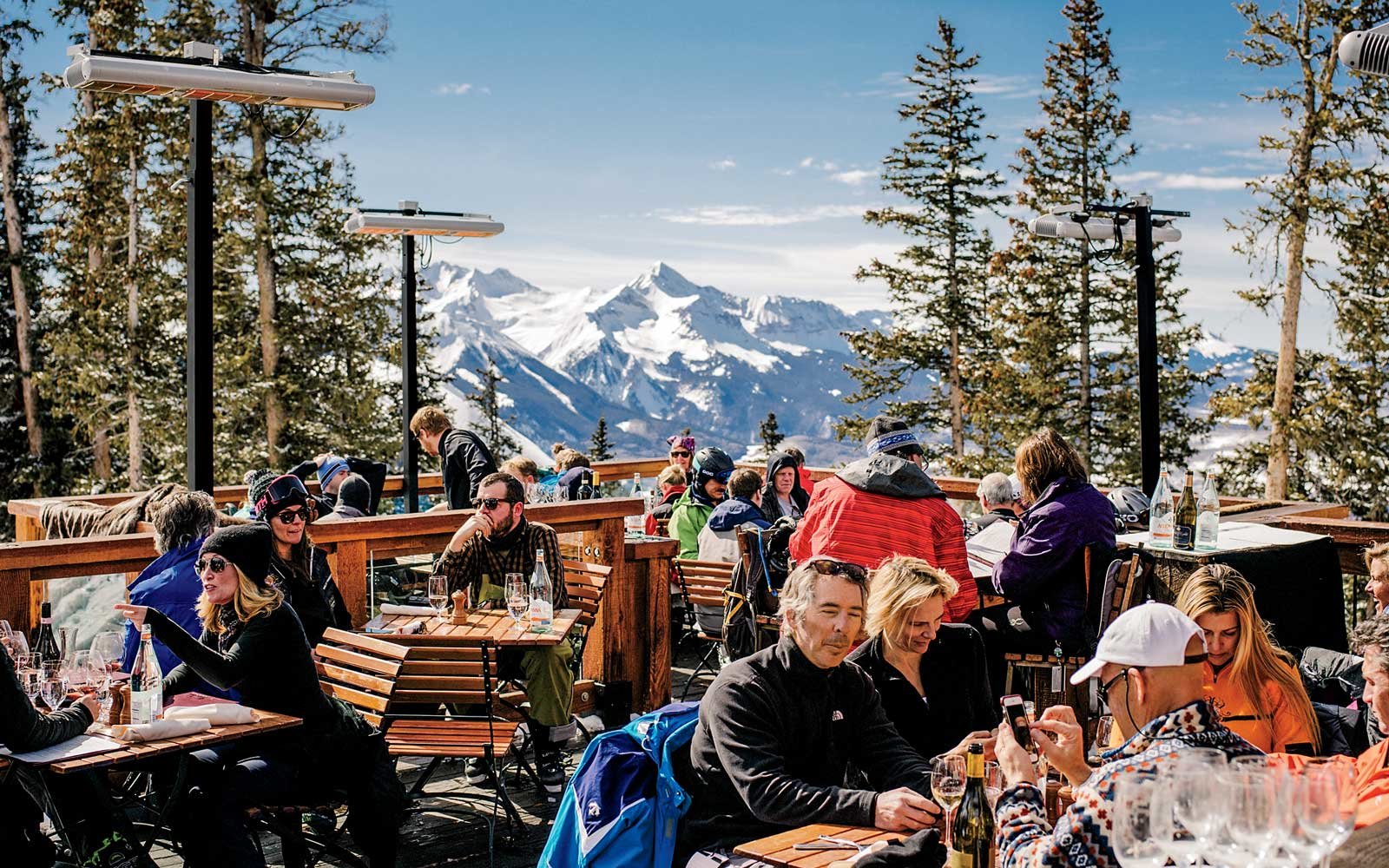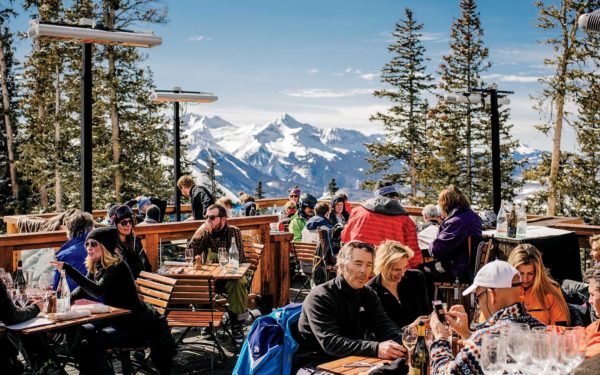
28 Jan Travel & Leisure Hearts Telluride
Telluride enjoyed a whole lot of love in 2017. Town & Country, Forbes, Free Skier, W, Vogue, Conde Nast, FW Lifestyle sang hosannas to our resort for its charm, scenery – and, of course, great skiing and riding. The new years kicks off with more plaudits, this time from David Amsden of Travel and Leisure, who weighs to present a case for why “Telluride Just Might Be America’s Coolest Ski Resort,” adding: “Though many of Colorado’s ski towns have become retreats for the superrich, Telluride remains true to its frontier roots.”

Alpino Vino, a restaurant and bar on a mountain in Telluride. Image, Jake Stange, courtesy Travel & Leisure.
As the plane began its descent into Telluride one afternoon, I pressed my face to the window, giddy with anticipation. For years, I had been only dimly aware of this southwestern Colorado town tucked into a remote canyon in the San Juan Mountains, a skier’s haven where Oprah Winfrey owns one of her many homes. And then, the way these things happen, Telluride began to exert a gravitational pull over various close friends, a normally jaded lot who started speaking about it with a vaguely cultish fervor, like techies talking about Burning Man. One particularly zealous proselytizer went so far as to compare his first encounter with its savage beauty to dropping acid.
From the plane window, however, I saw nothing. No mountains, no snow, no hallucinatory alpine utopia. A dense cloud system had gathered in the region, shrouding everything in a fog so blinding that the runway — the highest commercial strip in North America, perilously bookended by 1,000-foot cliffs — was visible only a split-second before the tiny prop plane touched down. On the taxi ride from the airport, instead of marveling at the canyon of sawtooth peaks that frame the destination like a colossal amphitheater, I saw only more of the static white murk. My driver, a benevolent old beatnik in a frayed leather cowboy hat, explained how unusual this was, how winters here tended to vacillate, with metronomic reliability, between skies that dump more than 300 inches of glorious powder and skies that shine a crystalline blue.
“But Telluride,” he then noted cryptically, “is about way more than just mountains.”
You get a lot of this talk here, quasi-mystical murmurings that make sense only if you know the town’s improbable history. Founded in 1878 as a mining colony, Telluride had, by the turn of the century, minted more millionaires per capita than Manhattan. It had also earned a reputation as a bawdy, half-civilized outpost of saloons and bordellos and wistful prospectors. (This is, after all, where Butch Cassidy robbed his first bank.) By the late 1960s, with the mining industry verging on collapse, the town was claimed by hippies, who found in it an idyll where they could get weird, 8,750 feet above sea level. Radical hedonism alone, however, was not enough to revive the economy. In 1972, the first ski lifts opened, and Telluride was reborn as a winter never-never land with an untamed, frontiersman sensibility.
As the plane began its descent into Telluride one afternoon, I pressed my face to the window, giddy with anticipation. For years, I had been only dimly aware of this southwestern Colorado town tucked into a remote canyon in the San Juan Mountains, a skier’s haven where Oprah Winfrey owns one of her many homes. And then, the way these things happen, Telluride began to exert a gravitational pull over various close friends, a normally jaded lot who started speaking about it with a vaguely cultish fervor, like techies talking about Burning Man. One particularly zealous proselytizer went so far as to compare his first encounter with its savage beauty to dropping acid.
From the plane window, however, I saw nothing. No mountains, no snow, no hallucinatory alpine utopia. A dense cloud system had gathered in the region, shrouding everything in a fog so blinding that the runway — the highest commercial strip in North America, perilously bookended by 1,000-foot cliffs — was visible only a split-second before the tiny prop plane touched down. On the taxi ride from the airport, instead of marveling at the canyon of sawtooth peaks that frame the destination like a colossal amphitheater, I saw only more of the static white murk. My driver, a benevolent old beatnik in a frayed leather cowboy hat, explained how unusual this was, how winters here tended to vacillate, with metronomic reliability, between skies that dump more than 300 inches of glorious powder and skies that shine a crystalline blue.
“But Telluride,” he then noted cryptically, “is about way more than just mountains.”
You get a lot of this talk here, quasi-mystical murmurings that make sense only if you know the town’s improbable history. Founded in 1878 as a mining colony, Telluride had, by the turn of the century, minted more millionaires per capita than Manhattan. It had also earned a reputation as a bawdy, half-civilized outpost of saloons and bordellos and wistful prospectors. (This is, after all, where Butch Cassidy robbed his first bank.) By the late 1960s, with the mining industry verging on collapse, the town was claimed by hippies, who found in it an idyll where they could get weird, 8,750 feet above sea level. Radical hedonism alone, however, was not enough to revive the economy. In 1972, the first ski lifts opened, and Telluride was reborn as a winter never-never land with an untamed, frontiersman sensibility.
Even though I couldn’t admire the landscape, a stroll through town was enough to stoke a pleasant delirium. The thin air was crisp and piney and laced with the unmistakable scent of burning marijuana. The ghosts of Telluride’s prospecting past lurked in studiously preserved gingerbread Victorians, tumbledown shacks, and stately Old West façades along the main thoroughfare, Colorado Avenue. And then there were the locals, an implausibly fit array of characters who seemed drawn from different chapters in Telluride’s history, all of whom emitted the distinct glow of people in their prime. I passed a sinewy septuagenarian walking around shirtless, seemingly unaware that it was 20 degrees outside. I passed a young dude with a teardrop tattoo gleefully recounting a brush with an avalanche. I passed Hilary Swank.
“It’s a deeply bonkers little corner of the world, isn’t it?” said Dabbs Anderson, an artist I met up with that first evening. We were at the Historic Bar at the New Sheridan Hotel, a dimly lit saloon with pressed-tin ceilings and a bustling billiard room, which has anchored the town since 1895. Anderson, a sunny blonde with pale blue eyes and a zanily outsize personality originally from Alabama, moved here a year ago from Los Angeles with her dog, a Great Dane named William Faulkner. We’d been put in touch through mutual friends and, over many martinis, discussed Telluride’s allure: the off-kilter mood, the unpretentious attitude, the emphasis on authenticity over ostentation that has built its reputation as the anti-Aspen. Where Aspen traded its countercultural past for Gucci and Prada, Telluride has no chain stores, no dress codes, no self-consciously swanky hotels. It does have an outdoor “free box” where locals recycle everything from clothing to cooking utensils.
“There’s a crazy amount of money here, of course, but it doesn’t define the place,” Anderson went on. “If people go to Aspen to flaunt their wealth, they come here searching for some kind of off-the-grid enrichment, whether they’re a celebrity or they live in a trailer. It’s a place people come to chase strange dreams, which also happens to have some of the best skiing on the planet.”
Anderson spoke from experience. She’d initially planned to stay only a month, having been offered an informal monthlong residency to work on her captivating, folkloric mix of drawings, paintings, and puppets at Steeprock, a mountaintop artists’ retreat in the tiny neighboring village of Sawpit. By the time her residency ended, however, Anderson saw no point in returning to Los Angeles and stayed on to help expand Steeprock’s program.
“The bustle, that buzzy anxiety, that survival mentality — I was burned out,” she told me. In Telluride, she found “a community of like-minded freaks,” as she put it. On warm days, she can often be seen gliding about in purple roller skates after a morning spent making haunting drawings using live gunpowder. When I met her, she was preparing for her first local solo show at Gallery 81435, one of the numerous showrooms and contemporary spaces in the downtown arts district.
“It’s kind of a crazy saga, but that’s the sort of thing that just happens here,” she said. “It has a way of sucking in a very specific type of person and scaring off the rest.”
With that, she polished off her drink and fixed me with a curious stare.
“Be careful,” she added, flashing a grin bright enough to power a nuclear reactor. “You may end up never leaving.”
The next morning, I woke to the bluest of skies and a penetrating hangover…


Sorry, the comment form is closed at this time.